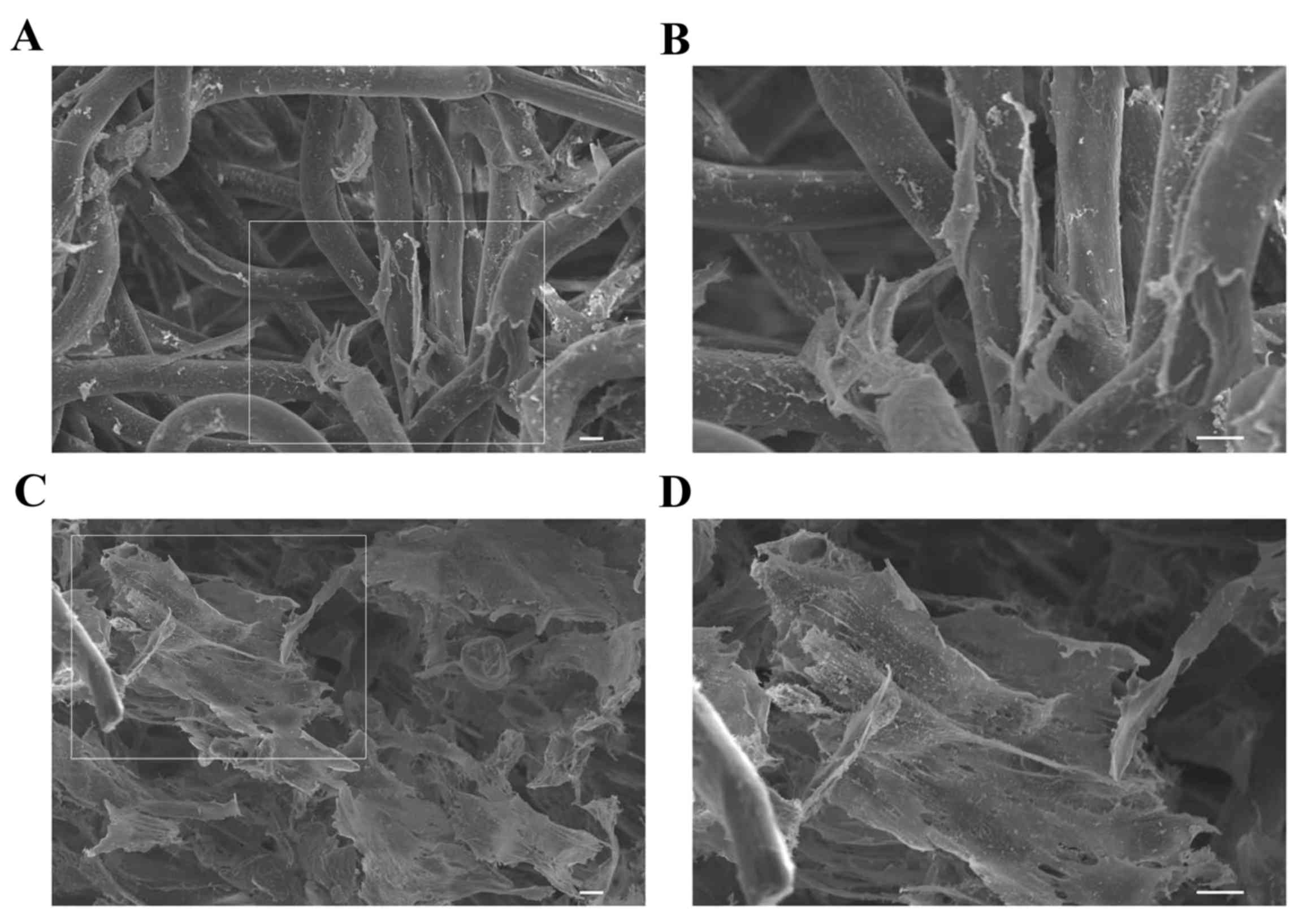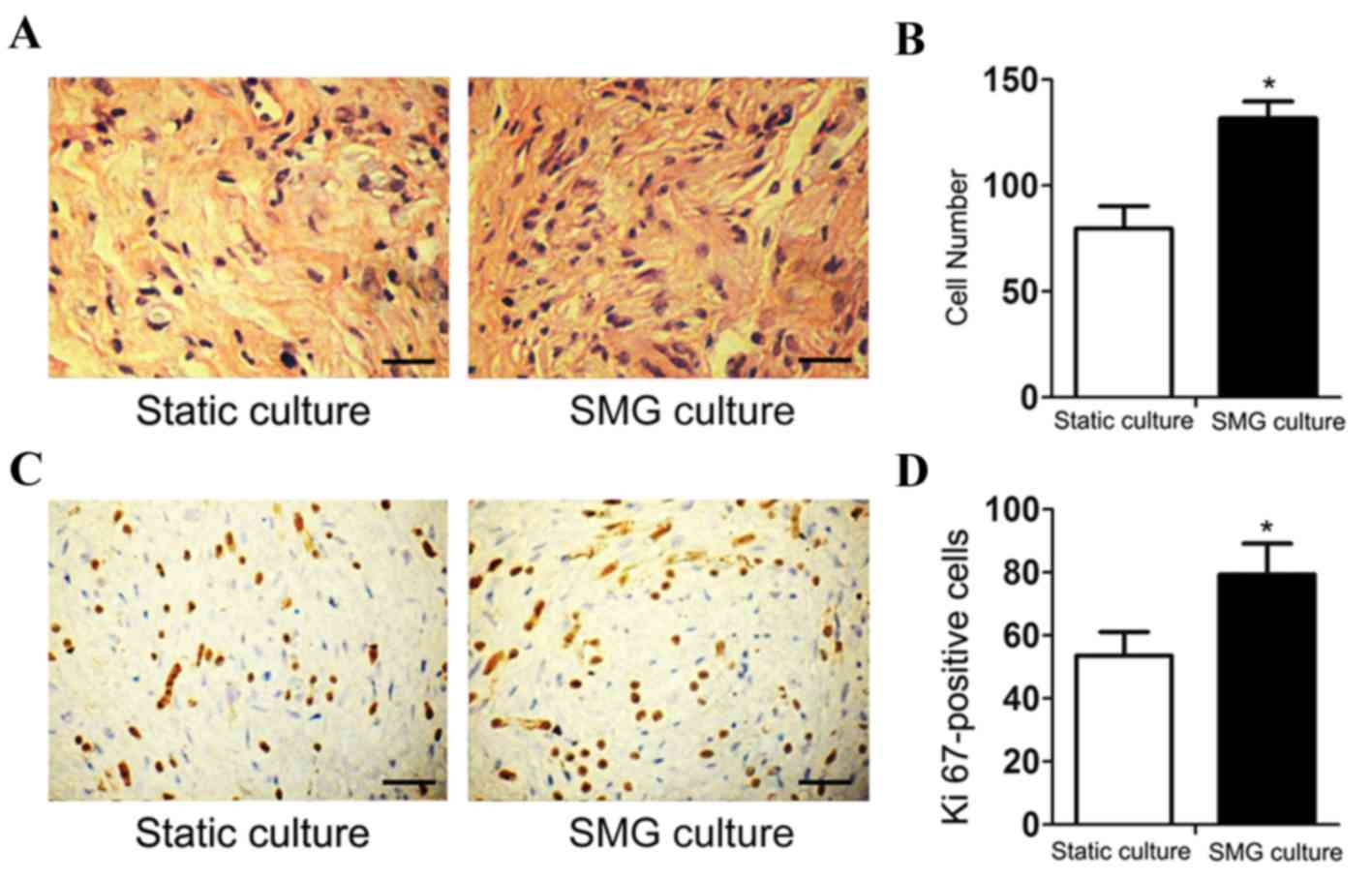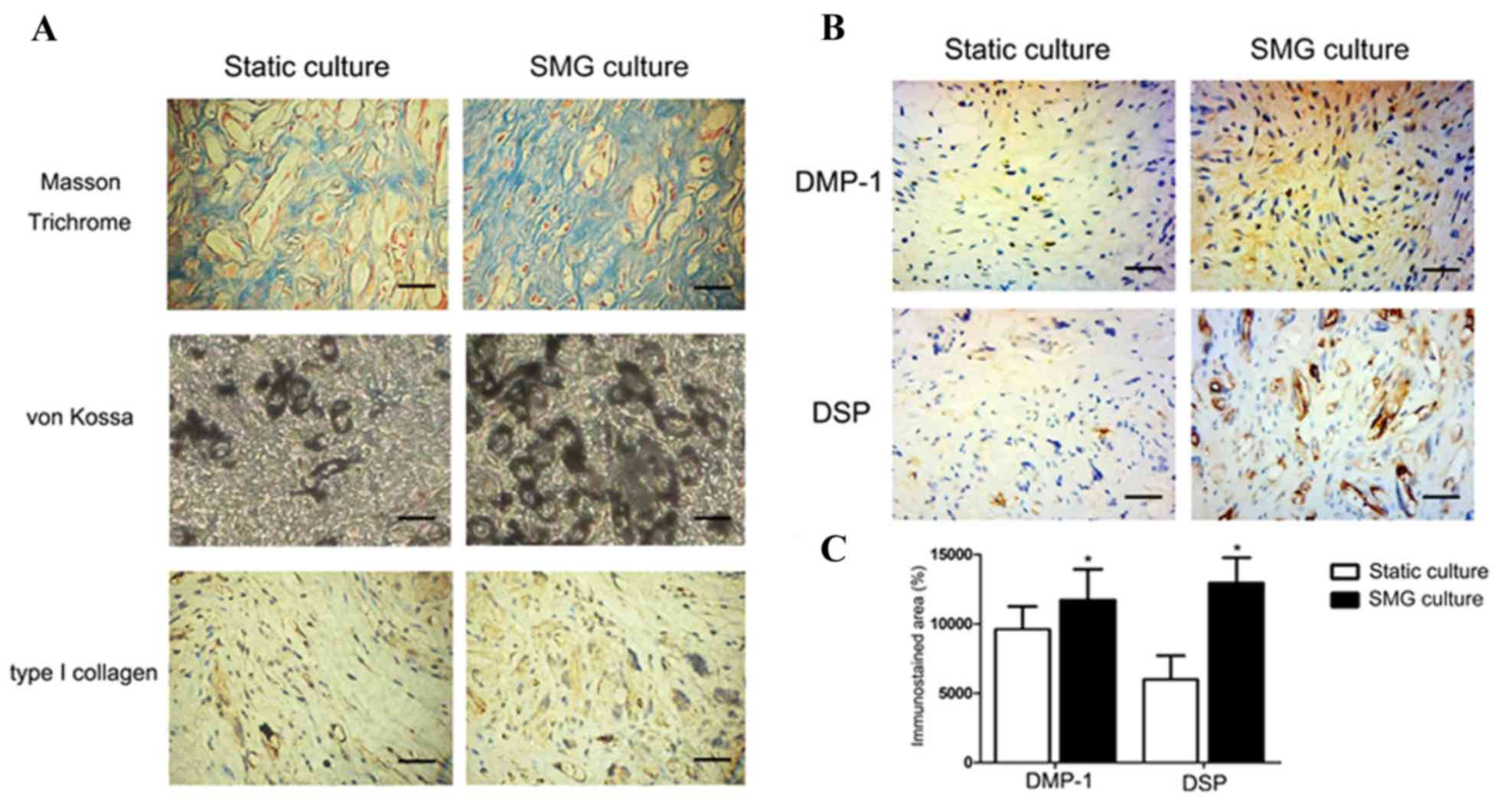|
1
|
Langer R and Vacanti JP: Tissue
engineering. Science. 260:920–926. 1993. View Article : Google Scholar : PubMed/NCBI
|
|
2
|
Gronthos S, Mankani M, Brahim J, Robey PG
and Shi S: Postnatal human dental pulp stem cells (DPSCs) in vitro
and in vivo. Proc Natl Acad Sci USA. 97:13625–13630. 2000.
View Article : Google Scholar : PubMed/NCBI
|
|
3
|
Rutzky LP, Bilinski S, Kloc M, Phan T,
Zhang H, Katz SM and Stepkowski SM: Microgravity culture condition
reduces immunogenicity and improves function of pancreatic islets1.
Transplantatio. 74:13–21. 2002. View Article : Google Scholar
|
|
4
|
Vilos C and Velasquez LA: Therapeutic
strategies based on polymeric microparticles. J Biomed Biotechnol.
2012:6727602012. View Article : Google Scholar : PubMed/NCBI
|
|
5
|
Lesman A, Koffler J, Atlas R, Blinder YJ,
Kam Z and Levenberg S: Engineering vessel-like networks within
multicellular fibrin-based constructs. Biomaterials. 32:7856–7869.
2011. View Article : Google Scholar : PubMed/NCBI
|
|
6
|
Lü JM, Wang X, Marin-Muller C, Wang H, Lin
PH, Yao Q and Chen C: Current advances in research and clinical
applications of PLGA-based nanotechnology. Expert Rev Mol Diagn.
9:325–341. 2009. View Article : Google Scholar : PubMed/NCBI
|
|
7
|
Holy CE, Shoichet MS and Davies JE:
Engineering three-dimensional bone tissue in vitro using
biodegradable scaffolds: Investigating initial cell-seeding density
and culture period. J Biomed Mater Res. 51:376–382. 2000.
View Article : Google Scholar : PubMed/NCBI
|
|
8
|
Inanc B, Elcin AE and Elcin YM: Osteogenic
induction of human periodontal ligament fibroblasts under two- and
three-dimensional culture conditions. Tissue Eng. 12:257–266. 2006.
View Article : Google Scholar : PubMed/NCBI
|
|
9
|
Rutzky LP, Bilinski S, Kloc M, Phan T,
Zhang H, Katz SM and Stepkowski SM: Microgravity culture condition
reduces immunogenicity and improves function of pancreatic islets1.
Transplantation. 74:13–21. 2002. View Article : Google Scholar : PubMed/NCBI
|
|
10
|
Hammond TG and Hammond JM: Optimized
suspension culture: The rotating-wall vessel. Am J Physiol Renal
Physiol. 281:F12–F25. 2001.PubMed/NCBI
|
|
11
|
Klement BJ, Young QM, George BJ and
Nokkaew M: Skeletal tissue growth, differentiation and
mineralization in the NASA rotating wall vessel. Bone. 34:487–498.
2004. View Article : Google Scholar : PubMed/NCBI
|
|
12
|
Goodwin TJ, Prewett TL, Wolf DA and
Spaulding GF: Reduced shear stress: A major component in the
ability of mammalian tissues to form three-dimensional assemblies
in simulated microgravity. J Cell Biochem. 51:301–311. 1993.
View Article : Google Scholar : PubMed/NCBI
|
|
13
|
Ohyabu Y, Kida N, Kojima H, Taguchi T,
Tanaka J and Uemura T: Cartilaginous tissue formation from bone
marrow cells using rotating wall vessel (RWV) bioreactor.
Biotechnol Bioeng. 95:1003–1008. 2006. View Article : Google Scholar : PubMed/NCBI
|
|
14
|
Qiu QQ, Ducheyne P and Ayyaswamy PS:
Fabrication, characterization and evaluation of bioceramic hollow
microspheres used as microcarriers for 3-D bone tissue formation in
rotating bioreactors. Biomaterials. 20:989–1001. 1999. View Article : Google Scholar : PubMed/NCBI
|
|
15
|
Khaoustov VI, Darlington GJ, Soriano HE,
Krishnan B, Risin D, Pellis NR and Yoffe B: Induction of
three-dimensional assembly of human liver cells by simulated
microgravity. In Vitro Cell Dev Biol Anim. 35:501–509. 1999.
View Article : Google Scholar : PubMed/NCBI
|
|
16
|
Martin A, Zhou A, Gordon RE, Henderson SC,
Schwartz AE, Schwartz AE, Friedman EW and Davies TF: Thyroid
organoid formation in simulated microgravity: Influence of
keratinocyte growth factor. Thyroid. 10:481–487. 2000.PubMed/NCBI
|
|
17
|
He L, Pan S, Li Y, Zhang L, Zhang W, Yi H,
Song C and Niu Y: Increased proliferation and adhesion properties
of human dental pulp stem cells in PLGA scaffolds via simulated
microgravity. Int Endod J. 49:161–173. 2016. View Article : Google Scholar : PubMed/NCBI
|
|
18
|
Lei XH, Ning LN, Cao YJ, Liu S, Zhang SB,
Qiu ZF, Hu HM, Zhang HS, Liu S and Duan EK: NASA-approved rotary
bioreactor enhances proliferation of human epidermal stem cells and
supports formation of 3D epidermis-like structure. PLoS One.
6:e266032011. View Article : Google Scholar : PubMed/NCBI
|
|
19
|
Wu C, Guo X, Wang F, Li X, Tian XC, Li L,
Wu Z and Zhang S: Simulated microgravity compromises mouse oocyte
maturation by disrupting meiotic spindle organization and inducing
cytoplasmic blebbing. PLoS One. 6:e222142011. View Article : Google Scholar : PubMed/NCBI
|
|
20
|
Freed LE, Hollander AP, Martin I, Barry
JR, Langer R and Vunjak-Novakovic G: Chondrogenesis in a
cell-polymer-bioreactor system. Exp Cell Res. 240:58–65. 1998.
View Article : Google Scholar : PubMed/NCBI
|
|
21
|
Pan H, Jiang H and Chen W: Interaction of
dermal fibroblasts with electrospun composite polymer scaffolds
prepared from dextran and poly lactide-co-glycolide. Biomaterials.
27:3209–3220. 2006. View Article : Google Scholar : PubMed/NCBI
|
|
22
|
McBane JE, Battiston KG, Wadhwani A,
Sharifpoor S, Labow RS and Santerre JP: The effect of degradable
polymer surfaces on co-cultures of monocytes and smooth muscle
cells. Biomaterials. 32:3584–3595. 2011. View Article : Google Scholar : PubMed/NCBI
|
|
23
|
Xue Y, Dånmark S, Xing Z, Arvidson K,
Albertsson AC, Hellem S, Finne-Wistrand A and Mustafa K: Growth and
differentiation of bone marrow stromal cells on biodegradable
polymer scaffolds: An in vitro study. J Biomed Mater Res A.
95:1244–1251. 2010. View Article : Google Scholar : PubMed/NCBI
|
|
24
|
Karadzic I, Vucic V, Jokanovic V,
Debeljak-Martacic J, Markovic D, Petrovic S and Glibetic M: Effects
of novel hydroxyapatite-based 3D biomaterials on proliferation and
osteoblastic differentiation of mesenchymal stem cells. J Biomed
Mater Res A. 103:350–357. 2015. View Article : Google Scholar : PubMed/NCBI
|
|
25
|
Miyashita S, Ahmed NE, Murakami M, Iohara
K, Yamamoto T, Horibe H, Kurita K, Takano-Yamamoto T and Nakashima
M: Mechanical forces induce odontoblastic differentiation of
mesenchymal stem cells on three-dimensional biomimetic scaffolds. J
Tissue Eng Regen Med. Jun 12–2014.(Epub ahead of print). PubMed/NCBI
|
|
26
|
Roozafzoon R, Lashay A, Vasei M, Ai J,
Khoshzaban A, Keshel SH, Barabadi Z and Bahrami H: Dental pulp stem
cells differentiation into retinal ganglion-like cells in a three
dimensional network. Biochem Biophys Res Commun. 457:154–160. 2015.
View Article : Google Scholar : PubMed/NCBI
|
|
27
|
Boukhechba F, Balaguer T, Michiels JF,
Ackermann K, Quincey D, Bouler JM, Pyerin W, Carle GF and Rochet N:
Human primary osteocyte differentiation in a 3D culture system. J
Bone Miner Res. 24:1927–1935. 2009. View Article : Google Scholar : PubMed/NCBI
|
|
28
|
Hassell T, Gleave S and Butler M: Growth
inhibition in animal cell culture. The effect of lactate and
ammonia. Appl Biochem Biotechnol. 30:29–41. 1991. View Article : Google Scholar : PubMed/NCBI
|
|
29
|
Glowacki J, Mizuno S and Greenberger JS:
Perfusion enhances functions of bone marrow stromal cells in
three-dimensional culture. Cell Transplant. 7:319–326. 1998.
View Article : Google Scholar : PubMed/NCBI
|
|
30
|
Yuge L, Kajiume T, Tahara H, Kawahara Y,
Umeda C, Yoshimoto R, Wu SL, Yamaoka K, Asashima M, Kataoka K and
Ide T: Microgravity potentiates stem cell proliferation while
sustaining the capability of differentiation. Stem Cells Dev.
15:921–929. 2006. View Article : Google Scholar : PubMed/NCBI
|
|
31
|
Li S, Ma Z, Niu Z, Qian H, Xuan D, Hou R
and Ni L: NASA-approved rotary bioreactor enhances proliferation
and osteogenesis of human periodontal ligament stem cells. Stem
Cells Dev. 18:1273–1282. 2009. View Article : Google Scholar : PubMed/NCBI
|
|
32
|
Qiu Q, Ducheyne P, Gao H and Ayyaswamy P:
Formation and differentiation of three-dimensional rat marrow
stromal cell culture on microcarriers in a rotating-wall vessel.
Tissue Eng. 4:19–34. 1998. View Article : Google Scholar : PubMed/NCBI
|
|
33
|
About I, Bottero MJ, De Denato P, Camps J,
Franquin JC and Mitsiadis TA: Human dentin production in vitro. Exp
Cell Res. 258:33–41. 2000. View Article : Google Scholar : PubMed/NCBI
|
|
34
|
Karjalainen S, Söderling E, Pelliniemi L
and Foidart JM: Immunohistochemical localization of types I and III
collagen and fibronectin in the dentine of carious human teeth.
Arch Oral Biol. 31:801–806. 1986. View Article : Google Scholar : PubMed/NCBI
|
|
35
|
Andujar MB, Couble P, Couble ML and
Magloire H: Differential expression of type I and type III collagen
genes during tooth development. Development. 111:691–698.
1991.PubMed/NCBI
|
|
36
|
Mao YQ, Ohsaki Y and Kurisu K:
Immunohistochemical study of the relationship between extracellular
matrix and root bifurcation in the mouse molar. Arch Oral Biol.
35:583–591. 1990. View Article : Google Scholar : PubMed/NCBI
|
|
37
|
Garcia JM, Martins MD, Jaeger RG and
Marques MM: Immunolocalization of bone extracellular matrix
proteins (type I collagen, osteonectin and bone sialoprotein) in
human dental pulp and cultured pulp cells. Int Endod J. 36:404–410.
2003. View Article : Google Scholar : PubMed/NCBI
|
|
38
|
Hao J, Narayanan K, Ramachandran A, He G,
Almushayt A, Evans C and George A: Odontoblast cells immortalized
by telomerase produce mineralized dentin-like tissue both in vitro
and in vivo. J Biol Chem. 277:19976–19981. 2002. View Article : Google Scholar : PubMed/NCBI
|
|
39
|
McKnight DA, Simmer JP, Hart PS, Hart TC
and Fisher LW: Overlapping DSPP mutations cause dentin dysplasia
and dentinogenesis imperfecta. J Dent Res. 87:1108–1111. 2008.
View Article : Google Scholar : PubMed/NCBI
|
|
40
|
Lee SK, Lee KE, Jeon D, Lee G, Lee H, Shin
CU, Jung YJ, Lee SH, Hahn SH and Kim JW: A novel mutation in the
DSPP gene associated with dentinogenesis imperfecta type II. J Dent
Res. 88:51–55. 2009. View Article : Google Scholar : PubMed/NCBI
|
|
41
|
He G, Dahl T, Veis A and George A: Dentin
matrix protein 1 initiates hydroxyapatite formation in vitro.
Connect Tissue Res. 44 Suppl 1:240–245. 2003. View Article : Google Scholar : PubMed/NCBI
|
|
42
|
Almushayt A, Narayanan K, Zaki AE and
George A: Dentin matrix protein 1 induces cytodifferentiation of
dental pulp stem cells into odontoblasts. Gene Ther. 13:611–620.
2006. View Article : Google Scholar : PubMed/NCBI
|
|
43
|
Narayanan K, Srinivas R, Ramachandran A,
Hao J, Quinn B and George A: Differentiation of embryonic
mesenchymal cells to odontoblast-like cells by overexpression of
dentin matrix protein 1. Proc Natl Acad Sci USA. 98:4516–4521.
2001. View Article : Google Scholar : PubMed/NCBI
|
|
44
|
Chaussain C, Eapen AS, Huet E, Floris C,
Ravindran S, Hao J, Menashi S and George A: MMP2-cleavage of DMP1
generates a bioactive peptide promoting differentiation of dental
pulp stem/progenitor cell. Eur Cell Mater. 18:84–95. 2009.
View Article : Google Scholar : PubMed/NCBI
|












